Best Shade Trees for Texas
I’m as willing as the next guy or lady to accept changes. However, when it comes to shade trees for your garden, I have to see real proof that some new tree will live up to its promise. I’m a tough crowd to please.
Over the years, I’ve found that for large parts (most) of Texas, there are only seven trees that measure up. Three others almost make the list. I’ll include them, and that will round us out to my own personal Top 10 of shade trees.
• Live oak. The most-revered shade tree in Texas (by many of us), live oaks are native from the Gulf Coast north almost to the Red River. They grow to be 35 or 40 feet tall and 75 or more feet wide. They are absolutely not good trees for small city lots! Evergreen. Subject to oak wilt in the Hill Country. There are specimens in Texas that are more than 500 and even 1,000 years old.
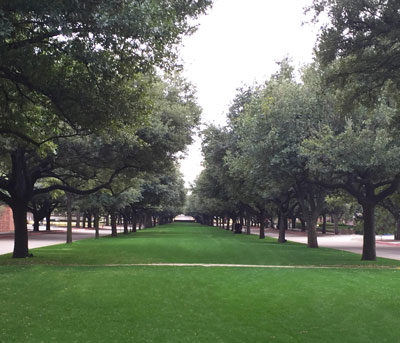
On SMU campus. These are not exactly in a residential use, but they show the size and growth form of live oaks. Think about how large these will be in another 450 years!
• Shumard red oak. Native to the Hill Country and up into North Central Texas. Mature height and width: 50 feet. Deep green summer color. Often has good red fall color (but not every year). Be very exacting in buying this tree, as pin oaks and other species are sometimes labeled as Shumards by big box stores. Let your local independent nursery guide you. Since this is my own personal Top 7, I’ll admit that this is my favorite shade tree.
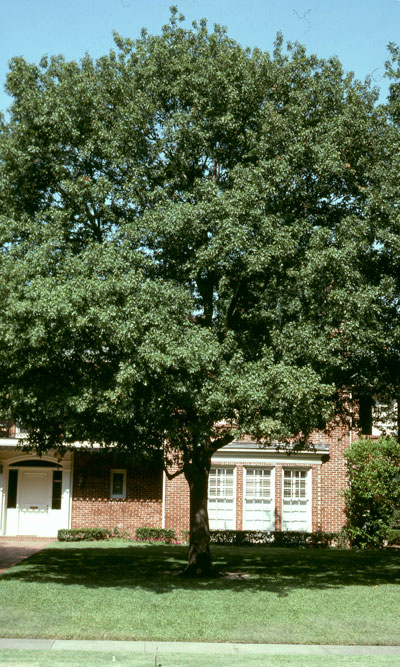
Shumard red oak
• Chinquapin oak. Native in river bottoms in North Central and East Texas. Grows to 50 feet tall and 45 to 50 feet wide. Deep green summer color. Poor fall color. Attractive, gray and platy bark. Least common of this list and worthy of far wider planting. Perhaps my second favorite shade tree for Texas.
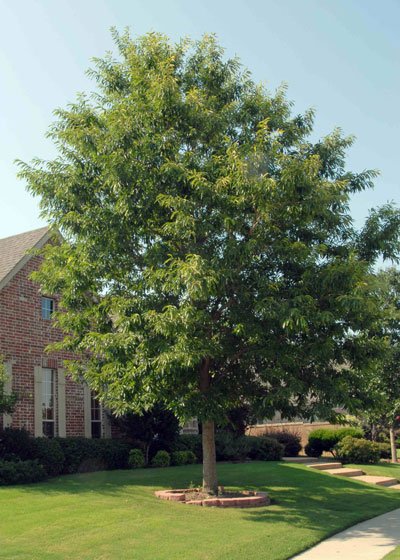
Chinquapin oak
• Bur oak. Mature height and width: 50 to 60 feet. Huge leaves. Huge acorns. Coarse-textured bark. This tree makes a bold statement to its surroundings. Native from Central Texas to Canada! Former arborist of the year Steve Houser of Arborilogical Services in DFW calls it “the best fast-growing shade tree.” While I’m not quite able to bring myself to saying that any fast-growing tree is very good, I will admit that this high-quality tree does grow more quickly than any of the others on our list here. Poor fall color.
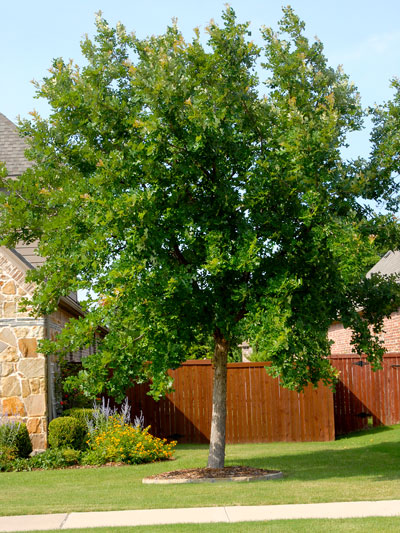
Bur oak
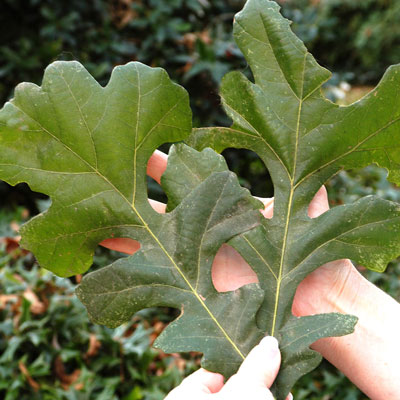
Bur oak leaves are, in a word, “huge!” These are my wife’s average-sized hands.
• Cedar elm. Most elms are not very good trees. Cedar elms are the shining exception. Native to North Central Texas, they’re adapted all over the state. They grow to be 50 feet tall and 40 feet wide. Small, deep green leaves. Yellow fall color. Only drawbacks are susceptibility to mistletoe. Prune it out as soon as you see it. Also, occasionally develops powdery mildew.
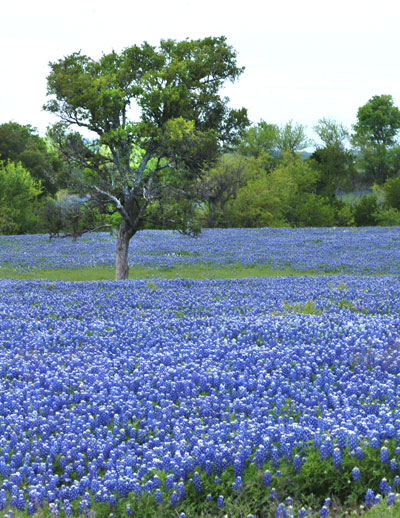
Cedar elm
• Pecan. Our state tree grows to be 60 feet tall and 50 feet wide. Native pecans will vary greatly in form and appearance, also in quality of the pecans they produce. If you’re planting a new one, buy a grafted tree of a variety recommended for your area. Several insects and diseases visit pecan trees, but most bother the pecans and not the tree. Spray as you choose.
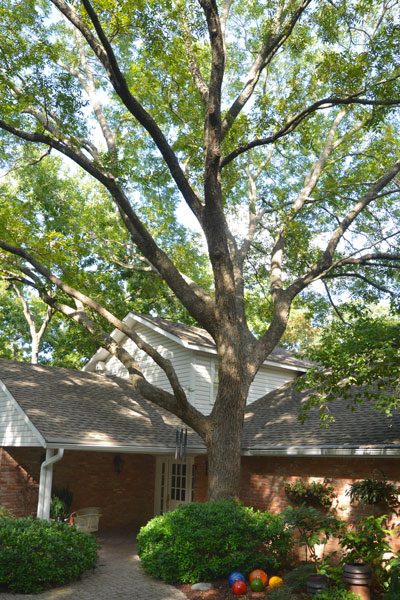
Native pecan towers over the Sperry house.
• Chinese pistachio. This is the only non-native among our trees. It grows to be 50 feet tall and wide. Attractive deep green summer foliage that turns reliably bright red each fall. Wrap the trunks of new trees for the first two or three years to protect them from damage by sunscald.
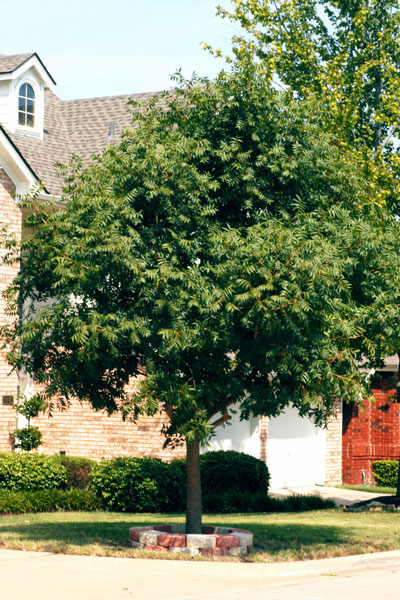
Chinese pistachio.
And three more for good measure…
Those seven are the best trees for almost all of our state. Limitations of temperature, adaptability to soils, pest issues and other variables score most other species down. In some cases, other species may still be very good choices for your area, but ask a Texas Master Certified Nursery Professional in your town for more specific advice.
• Southern magnolia. Matriarch tree of the South, this one grows to be 60 feet tall and 50 feet wide. Very large evergreen leaves and huge white flowers in May. Dense shade will eventually demand a shade-tolerant groundcover. Smaller varieties include Little Gem (half the size of the species) and Teddy Bear (smaller still, growing to be 15 to 18 feet tall and 12 to 15 feet wide). Needs deep soil, preferably acidic, neutral or only slightly alkaline. Very slow-growing compared to my Top 7.
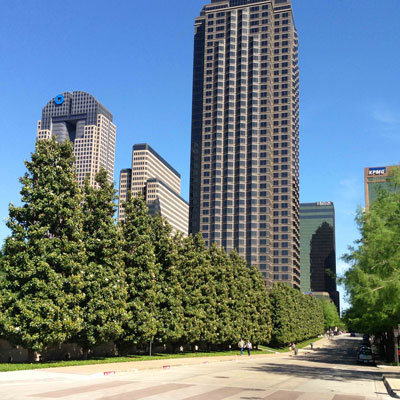
Southern magnolias have been trained to reflect vertical nature of Downtown Dallas. But you can still see their mature size.
• Water oak. Grows to be 50 feet tall and 45 feet wide. (One at the U.S. Capitol grounds requires several people to reach around.) Native to East Texas, and basically adapted only to areas from I-45 and eastward. Holds its leaves almost all winter. Very handsome tree where it’s adapted, but don’t plant it in the Blackland Prairie.
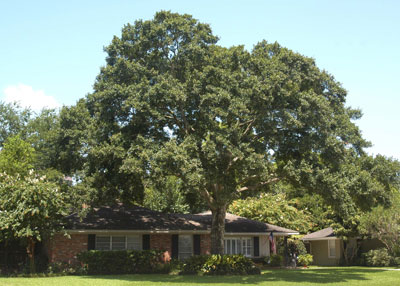
Water oak.
• Willow oak. Everything I just said about water oaks applies to this closely related species. The only difference is in the elongated, willow-like shape of the leaves. Again, only adapted to acidic soils of East Texas.
Finally, it should be noted that the “mature sizes” I have given are only estimated averages. These trees may grow larger in East Texas and eastward and stay shorter in drier West Texas. My estimates are intended only for matters of comparisons with other trees you might consider.
